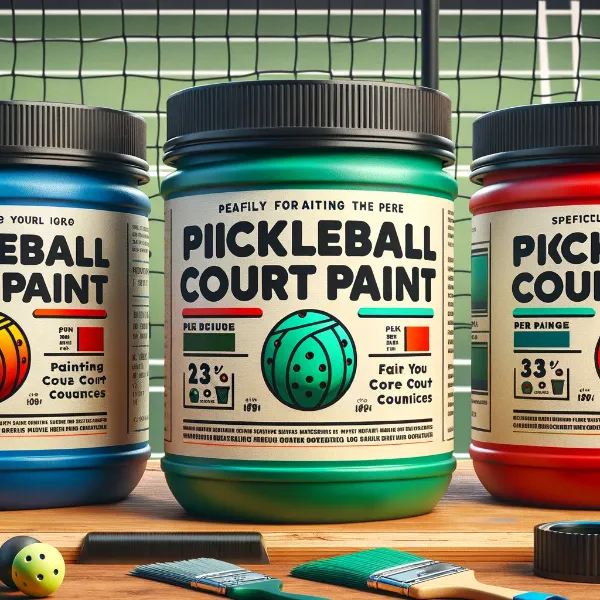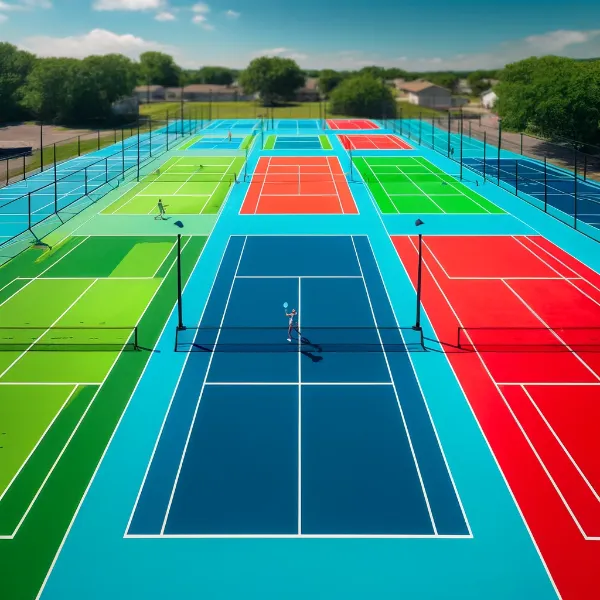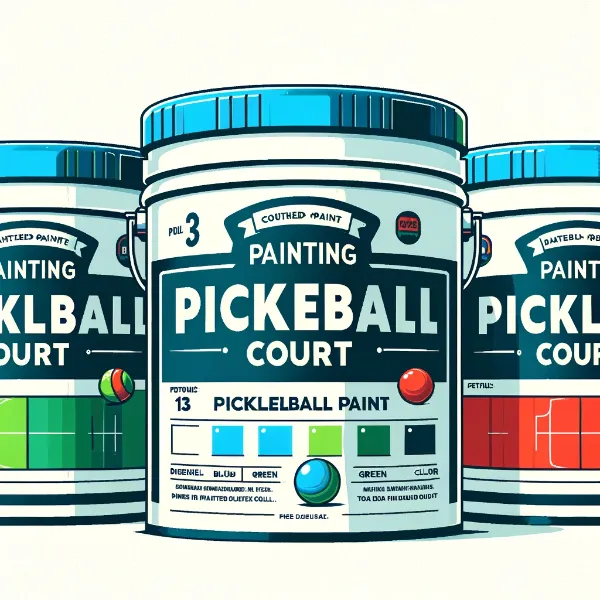If you’re a pickleball enthusiast, maintaining your court is crucial for an enjoyable playing experience. One key aspect of this is choosing the right pickleball court paint. This article will answer your top questions about pickleball court paint, including costs, and provide practical tips to keep your court in top shape.
Table of contents
- What is the Coating on a Pickleball Court?
- Types of Paint for Pickleball Courts
- How Much Paint is Needed to Paint a Pickleball Court?
- Cost of Painting a Pickleball Court
- How to Paint a Pickleball Court on Concrete
- Maintenance Tips for Painted Pickleball Courts
- Environmental Considerations
- Common Mistakes to Avoid When Painting a Pickleball Court
- Conclusion
What is the Coating on a Pickleball Court?
The coating on a pickleball court typically consists of a specially formulated paint designed to withstand the elements and heavy foot traffic. This paint often includes a blend of acrylic resins and pigments that provide durability and vibrant color. According to experts, using high-quality paint can improve your court’s longevity by up to 30%.
How to Choose the Right Pickleball Paint
When selecting paint for your pickleball court, consider the following:
- Durability: Look for paints that are designed to resist cracking and peeling.
- Texture: Some paints include texture additives to provide better traction.
- Color: Choose colors that enhance visibility and aesthetics.

Types of Paint for Pickleball Courts
Choosing the right type of paint can make a significant difference in the durability and appearance of your pickleball court.
Water-Based Paints
- Pros: Easier cleanup, environmentally friendly.
- Cons: Less durable in extreme weather conditions.
Oil-Based Paints
- Pros: More durable, better coverage.
- Cons: Longer drying time, requires solvents for cleanup.
How Much Paint is Needed to Paint a Pickleball Court?
Painting a pickleball court requires careful planning to ensure you purchase the correct amount of paint. On average, you will need about 7-10 gallons of paint to cover a standard pickleball court. This includes multiple coats to ensure even coverage and longevity.
Calculating Paint Quantity
To calculate the amount of paint needed, use the following steps:
| Step | Details |
|---|---|
| Measure the surface area | Calculate the total square footage of the court. |
| Determine paint coverage | Check the coverage rate of your chosen paint (usually listed on the can). |
| Multiply for multiple coats | Multiply the surface area by the number of coats you plan to apply. |
For instance, if your court is 2,000 square feet and the paint covers 350 square feet per gallon, you’ll need approximately 6 gallons for one coat. For optimal results, apply at least two coats.
Cost of Painting a Pickleball Court
The cost of painting a pickleball court can vary depending on several factors such as the type of paint used, the condition of the surface, and whether you hire professionals or do it yourself.
Cost Breakdown
| Expense | Estimated Cost |
|---|---|
| Paint (7-10 gallons) | $200 – $500 |
| Primer | $50 – $100 |
| Crack filler | $30 – $60 |
| Tools (brushes, rollers) | $40 – $100 |
| Professional labor | $500 – $1,500 |
| Total Estimated Cost | $820 – $2,260 |
DIY vs. Professional Painting
- DIY: If you choose to paint the court yourself, the cost will mainly be for materials, which can range from $320 to $760.
- Professional: Hiring professionals will add labor costs, bringing the total to $820 to $2,260. Professionals can ensure a high-quality finish and save you time and effort.
How to Paint a Pickleball Court on Concrete
Painting a pickleball court on concrete involves several steps to ensure a professional finish. Here’s a step-by-step guide:
Step-by-Step Guide
- Clean the Surface: First, remove all dirt, debris, and grease from the concrete.
- Repair Cracks: Next, use a concrete filler to repair any cracks or imperfections.
- Apply Primer: After that, use a concrete primer to help the paint adhere better.
- Paint the Base Coat: Then, apply the first coat of paint evenly across the surface.
- Add Lines: Once the base coat is dry, use a stencil or tape to mark the court lines.
- Final Coat: Finally, apply a final coat of paint to protect the lines and add durability.

Tips for Best Results
- Weather Conditions: Paint on a dry day with temperatures between 50-85°F.
- Tools: Additionally, use high-quality brushes and rollers for even application.
- Drying Time: Importantly, allow each coat to dry completely before applying the next.
Maintenance Tips for Painted Pickleball Courts
Proper maintenance can extend the life of your painted court and keep it looking new.
Seasonal Maintenance
- Spring: Clean the court thoroughly and inspect for any damage.
- Summer: Touch up any worn areas and ensure proper drainage to prevent water damage.
- Fall: Remove leaves and debris regularly to avoid staining.
- Winter: Protect the court from snow and ice buildup to prevent surface damage.
Common Issues
- Fading: Reapply a fresh coat of paint every few years to maintain vibrancy.
- Cracking: Fill in any cracks immediately to prevent them from worsening.
Environmental Considerations
Choosing eco-friendly paint options can benefit both your court and the environment.
Eco-Friendly Paints
- Low VOC: Look for paints with low volatile organic compounds to reduce environmental impact.
- Water-Based: Easier to clean up and less harmful to the environment.
Disposal
- Paint Cans: Dispose of empty paint cans according to local regulations.
- Leftover Paint: Donate leftover paint to community projects or recycle centers.
Common Mistakes to Avoid When Painting a Pickleball Court
Avoiding common pitfalls can save you time and money.
Common Mistakes
- Skipping Primer: Always use a primer to ensure better paint adhesion.
- Ignoring Weather: Paint only in suitable weather conditions to prevent poor results.
- Using the Wrong Tools: Invest in quality brushes and rollers for a smoother finish.
Solutions
- Primer: Always start with a good primer.
- Weather Check: Plan your painting project during ideal weather conditions.
- Quality Tools: Use high-quality painting tools for the best results.
Conclusion
Maintaining your pickleball court with the right paint can significantly enhance your playing experience and extend the life of your court. Whether you’re asking “What kind of paint do you use on pickleball lines on asphalt?” or “How to paint a pickleball court on concrete?”, this guide covers all your needs. Therefore, now that you know the basics, it’s time to get started on your court maintenance project!



